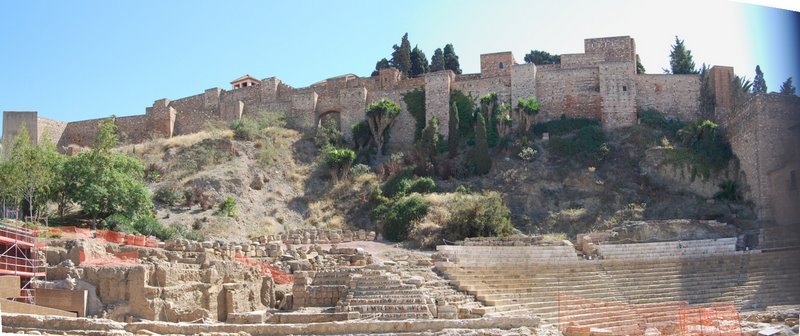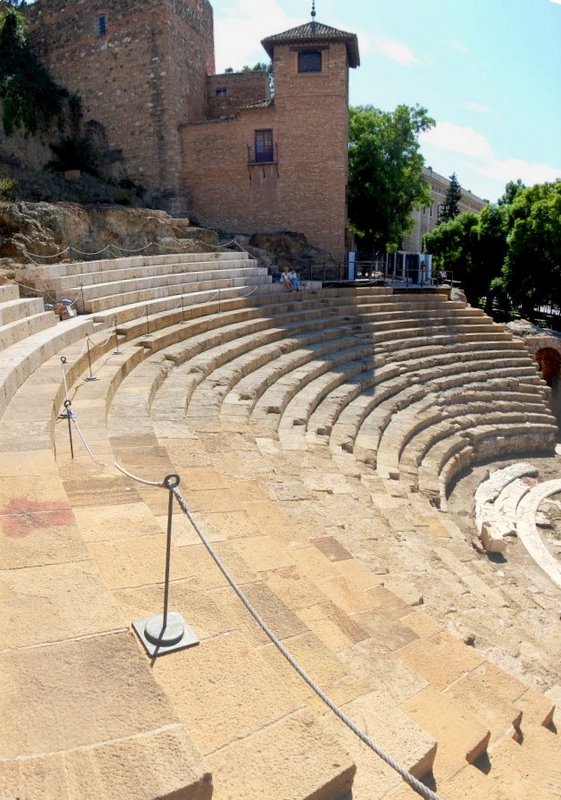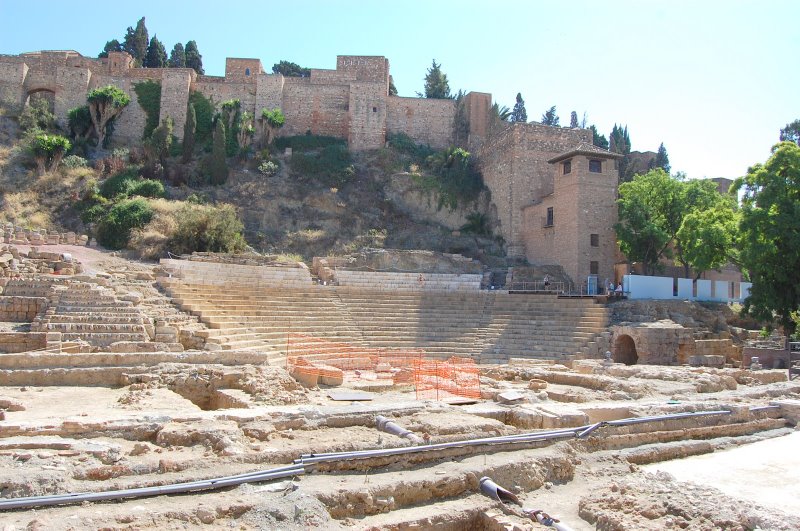Traces of the Phoenicians remain in a largely
unexcavated site near the mouth of the rio Guadalhorce --
and here where we find the ruins of an ancient Roman
theater. They built a city in terraces that climbed this
hill.
Let's look at the work of two of their successor
cultures shown here: The Moors used stone from the Roman
theater at bottom to build their Alcazaba at top. Over
the centuries, both fell into disrepair. The theater was
buried and forgotten; the Alcazaba (same etymological
root as "Casbah") was pretty much a pile of rubble until
1937 when Malagueños started restacking the stones
into the set of cubes that the tourist bureau calls
Spain's "best preserved" Arab fortifications. It may be a
stretch to call a restoration the "best preserved," but
these are undisputedly the largest -- and its information
center is among the best to explain the architecture of
Arab fortifications in Spain.
All Roman roads led to Málaga -- and
everywhere else

Most of the Mediterranean players of ancient history
displaced each other here including the Greeks (probably)
and (for sure) the Carthaginians who subsequently lost
Málaga to the Romans in 218 BCE after the Punic
Wars. Málaga then became an important town on the
Via Herculea, the first Roman road in Hispania. That road
ran from the Rhone (today's Italy/France border) all the
way to Gibraltar, about 65 miles west of where this
picture was taken as the pigeon flies. Eventually the
Romans connected over 50,000 miles into their colossal
road network. (The Americans tried to duplicate that feat
with their interstate system starting in the Eisenhower
1950s. That road system is called the largest public
works system in history - yet it's 4000 miles shorter
than the road system that connected Málaga to the
Roman Empire.)

Pax and rocks Romana
This theater was rediscovered by accident in 1951 when
expanding the Cultural Center (town down in 1988) which
rose over it. In the 1950s, other buildings were placed
over the site even though by then the town knew there was
this theater below. This part of the Roman Empire was
called Hispania Ulterior and included at first primarily
the Guadalquivir valley accessed through Cadiz where
young officers on the rise, such as Julius Caesar, were
assigned. Emperor Augustus later restructured the Spanish
provinces and built this theater, one of the oldest in
Iberia. Roman Spain was so peaceful that the Empire did
not permanently station troops here.

About half of the original seats remain although these
shown above are obviously new. The theater fits the
classic layout of the great Roman architect Vitrubio.
Holes in the marble show where the poles would have been
placed to hold a canopy to shield the Mediterranean sun
from viewers' eyes.
The Romans used Málaga to feed Rome. Grains came
from the fertile alluvial soil deposited by its two
rivers. Fish from the sea could not survive such a long
journey, but Málaga became famous for a fish sauce
(made of fish intestines, pepper, and vinegar) which the
wealthy Romans called "garo" and used much like we use
soy sauce today. They also used it as an aphrodisiac as
Pfizer had not created its mirable dictu
yet.
In 325, before Christianity became the official Roman
religion, Málaga was known as a Christian center
which often rioted against those still clinging to their
pagan gods -- 1200 years before the Spanish
Inquisition.

Technically, the Romans conquered Málaga twice:
First was during the Punic Wars around 218 BCE. The decay
of the Rome allowed Germanic Vandals to capture the town
around 411 CE. The second conquest was by the Byzantine
Emperor Justinian I (527-565 CE) who attempted to restore
the western Roman Empire and made Málaga the
capital of his province of Spania. But the eastern Roman
Empire could not hold the west from the invading
Visigoths who took Málaga in 615 BCE. Within a
century, came the Moors. They stayed 8 centuries --
longer than anyone else so far.
Next we climb the hill to visit the largest Moorish fort
still standing in Ibera, Málaga's Alcazar.
Join us by clicking
here.
If you have good bandwidth, Please join us in
the following slide show to give the
Málaga, Spain the viewing it deserves by clicking here.
|
|
